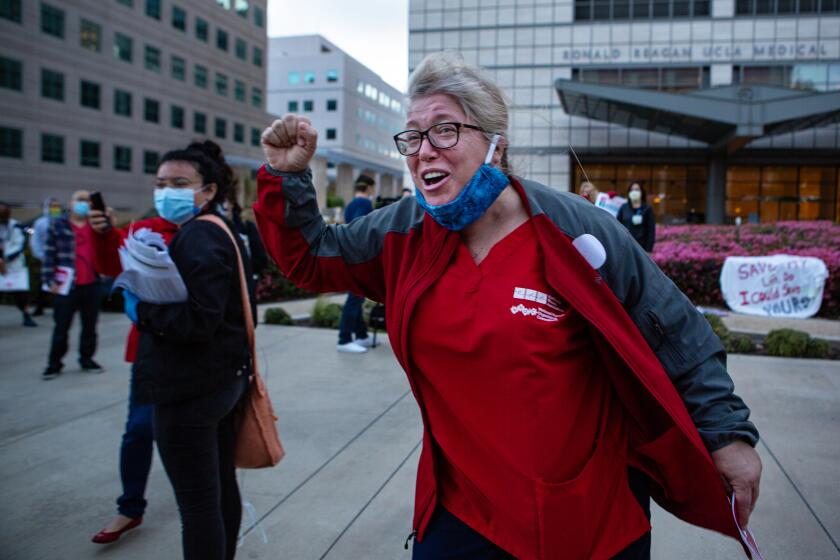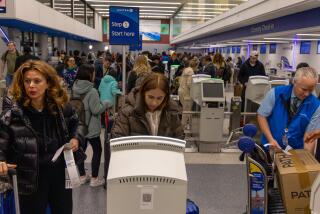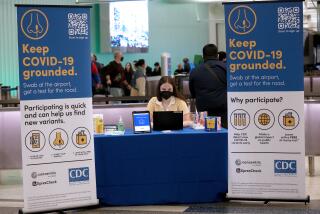From quiet acceptance to ‘crippling fear,’ medical workers confront their own mortality

- Share via
As the coronavirus tore through California in March, Dr. Amit Gohil bought his family a new board game: Pandemic.
A pulmonary critical care doctor at Santa Clara Valley Medical Center, Gohil has asthma and diabetes, risk factors for COVID-19, and has been treating infected patients for weeks. At age 43, he is acutely aware his life could be cut short.
He hoped the game, with its heroes of scientists and researchers, could be a way to help his children feel a sense of control over the virus, a story they all know could end badly.
“The kids say, ‘Dad, are you going to die?’ And I say, ‘Don’t worry about it,’” Gohil said.
But he agonizes all the time.
He gets home from a shift at the hospital and thinks to himself, “If I die next week what do I want to teach the kids? What haven’t I taught them?”
Numerous Californians look forward to a loosening of social distancing, but many doctors, nurses and other front-line medical workers say they feel caught in a state of perpetual danger and anxiety, with no end in sight. Some are taking extreme steps not just to survive but to protect those they love. They are making wills, sleeping in cars to self-quarantine, looking to buy life insurance and turning to prayer.
A flattened curve carries little relief for those inside hospitals or in places such as clinics and nursing homes. For them, replacing a peak with a plateau portends a long, ominous line of coronavirus patients stretching out for months or longer, amid the reality that co-workers are testing positive and even dying.
More than 3,100 medical workers have tested positive so far in California, nearly 500 of those confirmed workplace exposures. In nursing homes, nearly 1,300 staff have tested positive, and as of last week, 10 healthcare workers in California have died after contracting COVID-19.
The latest maps and charts on the spread of COVID-19 in California.
While some nurses have refused to work without adequate personal protective equipment, other healthcare workers say they feel reasonably protected, and remained committed to the job of saving lives, despite the danger. Their fear is often mixed with a sense of empowerment, as many see the novel coronavirus as the defining moment of their medical careers — a chance to put all of their training to use.
“The world is saying we’re healthcare providers and we’re heroes, but I don’t know what to make of that,” said Dr. Adjoa Boateng, a physician at Santa Clara Valley Medical Center in Silicon Valley, one of the hardest-hit areas in the state. “I’m doing the job I love and the job that I vowed to perform.”
Hospitals across California have been slow to reveal COVID-19 cases among medical staff, data that they are not required to disclose and that the state does not comprehensively track.
But their pride is mixed with anger. Some are baking masks in ovens to decontaminate them, sending children to stay with relatives and eking out control in private lives, since they have so little at work.
“It’s like going on a battlefield and you don’t know if you are stepping on a mine,” said a medical technician in West Los Angeles, who asked to remain anonymous because he fears retaliation from his employer. Like many of his colleagues, he has been frustrated by the constant shortfall of equipment — he has been interacting with suspected coronavirus patients with only a paper mask.
A few weeks ago, the 34-year-old contracted COVID-19, as did another co-worker.
It hit him hard in the middle of a shift, with a fever and body aches. He knew he couldn’t go home to his wife and twin 2-year-olds, so he called and had his spouse, also a medical worker, pack bags for him and leave them outside.
Then he checked himself into a hotel for three days, which cost him about $450, before moving into his brother’s back house alone. His family left food outside the door.
“I was crying,” he said of having to tell his loved ones he was positive. “I told myself, I am going to survive this.”
But, he said, the illness got bad enough that he began to have doubts.
“The first four days, it was one of the worst things of my life — waking up in the middle of the night, waking up every day throwing up, coughing,” he said. “I felt like lava was burning up in my throat.”
The hardest part, though, was knowing his little kids didn’t understand why he was gone. His daughter called him whenever she could get her hands on her grandmother’s cellphone.
“To me that was very touching but very sad,” he said. “I wanted to be there and hug them, but I couldn’t.”
Younger medical workers are also aware of what the data are revealing: Physicians are seeing unexpectedly high numbers of people in their 30s and 40s admitted with severe COVID symptoms, greater than what was reported in China and Italy.
“The idea that this is a disease of the elderly is totally debunked at this point,” said Dr. Andrew Lim, a critical care and emergency physician working in Santa Clara County hospitals.
The 33-year-old doctor said he didn’t internalize it until he saw it himself. During a night shift, a young, healthy patient who had followed the stay-at-home orders showed up in the ER. Within hours, the patient became suddenly worse and required oxygen and intubation in rapid succession.
That was a turning point for Lim.
“I thought, ‘Oh, I’m vulnerable to this, too,’” Lim said. “I felt my own mortality so acutely.”
At first, that meant planning for the worst. He remembers thinking, “Do I need to review my finances with my wife? Just to make sure she has all of the information if I do get sick and pass away.”
But now he has entered a new phase of acceptance. “All of us healthcare workers know that it’s going to be like this probably through the fall,” he said. “As things start opening up, healthcare workers are realizing they’re going to be in a possibly different ballgame [than the general public] for six months to a year.”
Kim Ballon, a home healthcare worker in Ventura County, said lack of respect for the difficulty of the job is one of her biggest challenges. She gets paid a little more than $13 an hour to care for elderly clients in their homes.
“I want people to know our work is at the forefront of this crisis,” Ballon said. “We are changing diapers in these homes. We are showering people .... draining catheters or colostomy bags. The virus is everywhere ... it’s in the body fluids. We’re doing the same things that happen in a nursing home, a rehab center, a hospital, but we are forgotten about,” she said.
She receives one mask a week and sprays it with Lysol every night. She would like the public to value her and other home healthcare workers more.
“We are equal, period,” Ballon said. “But we are at the bottom level of health service. We are not important.”
Andrea Tuma, a respiratory therapist at Mercy Medical Center Redding, said she struggles to do right by those in her personal life while still doing her job. Many questions are running through her and her colleagues’ heads, she said.
“How do I take care of everybody else and still protect myself and my family? How do I make sure that I protect my family while I’m taking care of other people’s families, and what does that look like?”
“We are all stressed.”
Since she can’t stay home from work, she is finding other ways to minimize exposure to the virus both for herself and them. She buys enough food during each grocery store trip that she needs to go only once every two weeks, she said. She also undresses in her garage and throws her clothes immediately in the washing machine so no one else in her family touches them.
For Dr. Christine Chen, an emergency room doctor at the Santa Clara Valley Medical Center, and her husband, an ICU doctor, their toddler son has been the biggest concern. They feared that they would infect the 15-month-old child, or their nanny.
“We have a wonderful babysitter,” Chen said. “But her family includes elderly people, and we’d feel awful if they were to get sick.”
The couple made the hard decision to send the baby nearly two hours away to his grandparents in Sacramento, taking turns visiting every few days. With the toddler gone, they tried to make their home impervious to the coronavirus, a different kind of baby-proofing than they’d ever imagined.
“We’re at the age where everything goes into the baby’s mouth,” Chen explained. They installed hooks and shelves to ensure potentially dirty items can’t be reached. And they made a “decontamination zone” for shoes and dirty clothes. The nanny ultimately decided it was too much of a risk to her own family to continue to care for their son.
But Chen and her husband found a small home daycare that’s staying open for the children of essential workers. After three weeks apart, they were able to bring their baby home.
Family separations are becoming more common, especially between adult children and aging parents.
A nurse at a Westside hospital said he stopped visiting his parents because he’s worried about infecting them. He typically visits often since they live nearby, he said. But they are both older than 60, and he wants to be safe, he said.
“Of course, they’re more concerned about me and I’m more concerned about them,” he said.
A doctor at a large L.A. hospital said she and her partner, who is also a doctor, have begun sleeping in different rooms in their home so they don’t infect each other if one of them brings home the coronavirus.
Like the Westside nurse, she has stopped visiting her parents, who live an hour away, because they are both over 60. It could be months before she sees them again.
She said she and her partner recently updated their advanced directives, in case they end up on ventilators, and put their finances in order.
“I wish I could stay at home and quarantine for the next few months,” she said. “I wish I had the same luxury of boredom instead of crippling fear because I have to go into the hospital every day.”
More to Read
Sign up for Essential California
The most important California stories and recommendations in your inbox every morning.
You may occasionally receive promotional content from the Los Angeles Times.
















